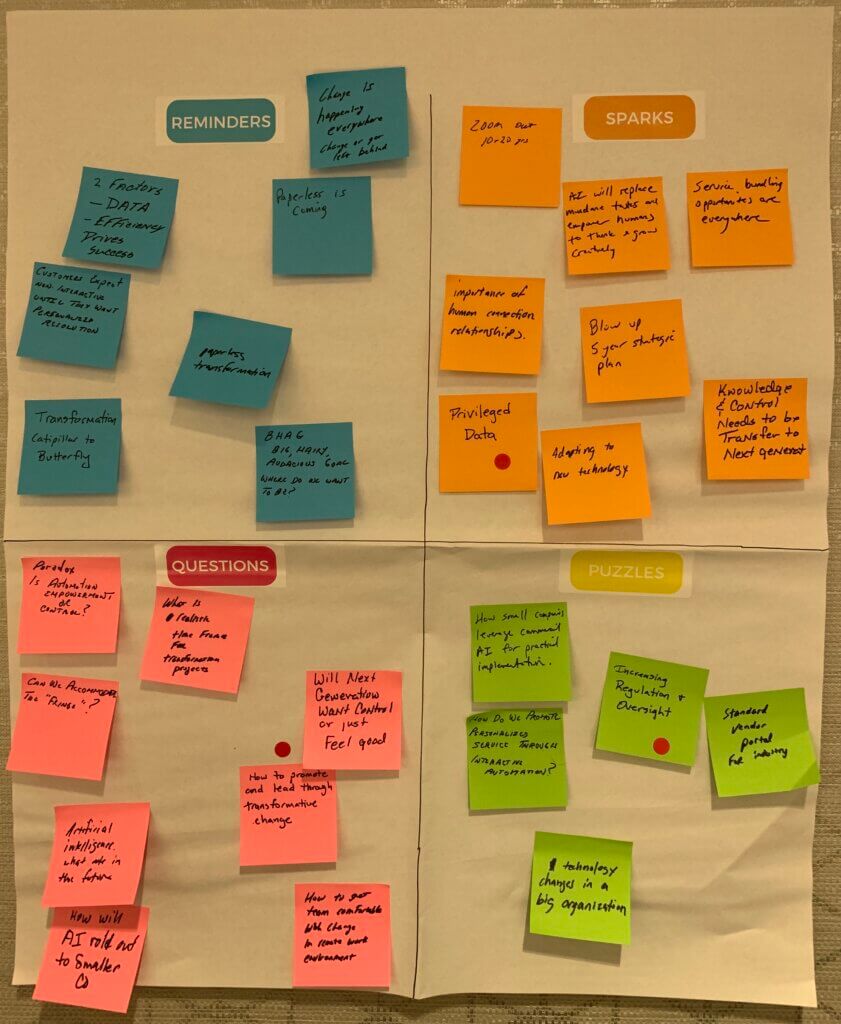Event design
Connect the dots not collect the dots
Connect the dots, not collect the dots. How can we maximize the real value of a meeting? By maximizing how participants “connect the dots”—what they actually learn from their experiences at the meeting—rather than documenting what we or they think they should have learned.
Seth Godin makes the same point when talking about the future of education and what we can do about it in his 2012 TEDxYouth@BFS talk. Watch this 30-second clip.
Video clip transcript: “Are we asking our kids to collect dots or connect dots? Because we’re really good at measuring how many dots they collect, how many facts they have memorized, how many boxes they have filled in, but we teach nothing about how to connect those dots. You cannot teach connecting dots in a Dummies manual. You can only do it by putting kids into a situation where they can fail.”
—Seth Godin at TEDxYouth@BFS in the Youtube video STOP STEALING DREAMS
Stop collecting dots
Too many meetings continue to use short-term superficial evaluations as evidence for the efficacy of the event. We know that these kinds of meeting evaluations are unreliable (1, 2, 3). Luckily there are better ways to find out whether participants have learned to better connect the dots. Here are four of them:
- The Reminder.
- Ask the right questions.
- A Letter to Myself.
- Research KPIs and obtain Net Promoter scores.
Instead, design meetings to connect the dots
Here are five suggestions:
- Build your event around conversation rather than content.
- Maximize social connection by making it an integral component of every session.
- Give people permission to connect.
- Design sessions where the audience can’t stop talking about what they did.
- Give attendees experiences, not things.
Finally, an example of what can happen when you design meetings with these ideas in mind: Linda’s very different experiences at TradConf and PartConf.
P.S.
Today, Seth Godin posted this:
“Hardy came home from school and proudly showed his mom the cheap plastic trinkets he had earned that day.
‘I stood quietly on the dot and so I got some tickets. And if I stand on the dot quietly tomorrow, I can get some more prizes!'”
…
“Is standing on a dot the thing we need to train kids to do? Has each of us spent too much time standing on dots already?”
—On the dot, Seth Godin
Meeting room designs for both in-person and remote participants
Now that small hybrid meetings are commonplace, what meeting room designs work for a mixture of in-person and remote participants?
Read the rest of this entry »
Exploring the Second Question
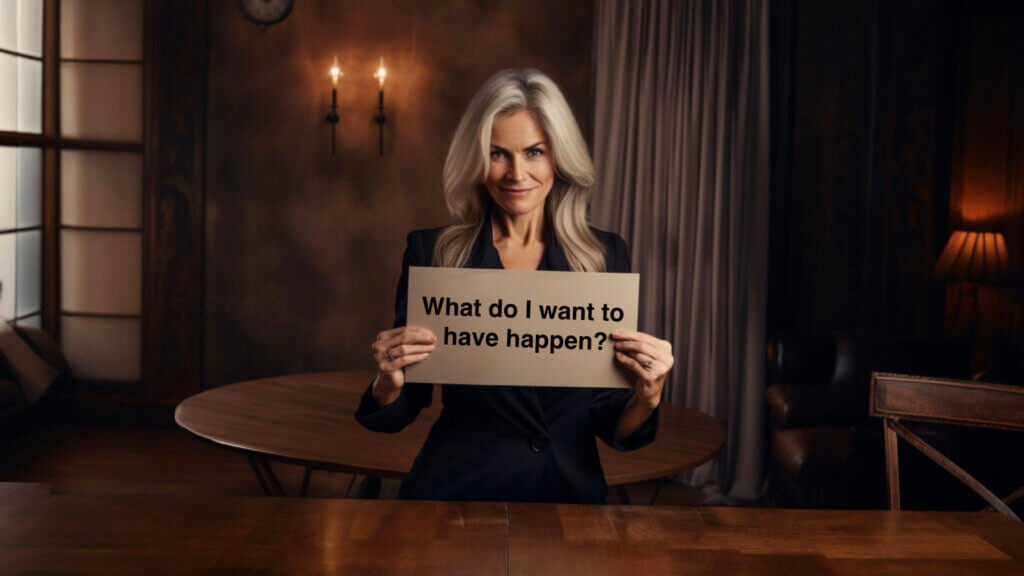
“What do I want to have happen?”
How people respond to the Second Question
The Second Question goes to the heart of the peer conference (aka unconference) process. Answering it gives every person present, in turn, an opportunity to share what they would like the ensuing meeting to be about.
Over the years, I’ve noticed a subtle difference between first-time peer conferences and subsequent gatherings of the same community. At first-time gatherings, it’s more likely that some people (typically ~10%) will respond with an answer that comes down to:
“I’m here because I want to learn from others.”
These people are hesitant to share specific top-of-mind issues or questions they have. Of course, that’s OK because there are no wrong answers to The Three Questions. On the other hand, I suspect that many of those who respond this way do have topics or questions, but for a multitude of reasons don’t share them when it’s their turn.
At subsequent community conferences, my experience is that such a response is less likely. Those who offer it are usually first-time attendees. I think participants are more likely to be specific at repeated events because they have experienced the flowering of discussion and sessions based on what is shared during The Three Questions. They have seen that they have the potential to personally shape the peer conference toward their wants and needs.
The limitations of “I want to learn from others”
Again, there’s nothing wrong with an attendee’s answer: “I want to learn from others.” From a group perspective, however, this response doesn’t enrich the set of ideas, topics, and questions that the ensuing meeting could address. (If everyone answered this way, the group would know no more about its collective wants and needs than before The Three Questions started!)
So, a few years ago I added an extra prompt to my original introduction to The Three Questions.
How I encourage deeper responses to the Second Question
I simply add this refinement:
“Some people say ‘I want to learn’. That’s fine, but try to go deeper if you can. See if you can come up with three specific things you’d love to get out of this conference.“
Depending on the conference, I then sometimes supply an example of ideas, topics, and questions that my client thinks might be top-of-mind. For example, writing this in 2023, I might mention artificial intelligence. Then I’ll add that anything of interest can be shared, at any level of detail. For example:
- They are using artificial intelligence and want to talk to others who are exploring the same approach; or
- They are wondering how AI will affect their profession; or
- They simply want to learn more about AI.
How well does this refinement work?
I know that this simple addition has encouraged some people to share more deeply because I now routinely hear attendees say something like, “The N things I want to learn/understand/have questions about are…”. And I suspect that others have been nudged to be more specific too.
Do I still hear “I want to learn from others”? Yes, I do! But not as often as before. And that’s fine!
Combining facilitation tools
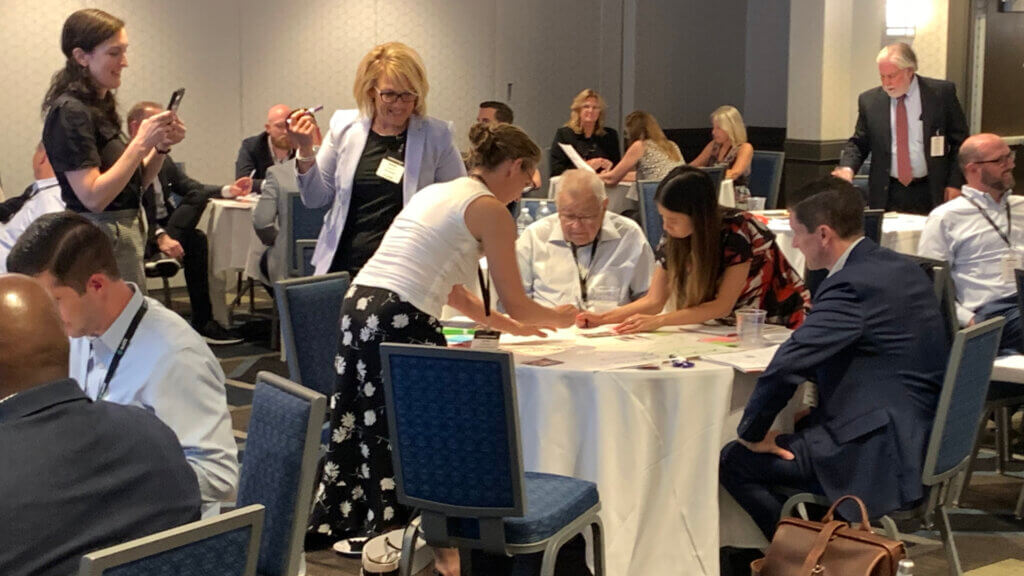
My 2014 post on RSQP gives a clear example of how it works (and my book Event Crowdsourcing includes full details) so I won’t repeat myself here. The 2014 and the recent conference each had around 200 participants, so the process and timing (around 25 minutes) were pretty similar.
But there were two significant differences.
Two significant differences
1. Conference length
The 2014 conference ran for three days.
But the 2023 conference ran a mere eight hours, from 8:30 AM – 4:30 PM on a single day.
2. How we used the gallery created by RSQP
The 2014 conference didn’t use the RSQP gallery to directly influence what would happen during the rest of the conference. A small group of subject-matter experts clustered key theme notes into a valuable public resource for review throughout the event. Participants simply used the clustered gallery to discover what their peers were thinking.
In contrast, I designed the 2023 conference to explore the future of a 50-year-old industry, and we needed to use the information mined by RSQP to create same-day sessions that reflected participants’ top-of-mind issues, questions, and concerns. We had just 2½ hours to:
- review the information on nearly a thousand sticky notes;
- determine an optimum set of sessions to run;
- find facilitators for the sessions; and
- schedule the sessions to time slots and rooms.
Combining facilitation tools
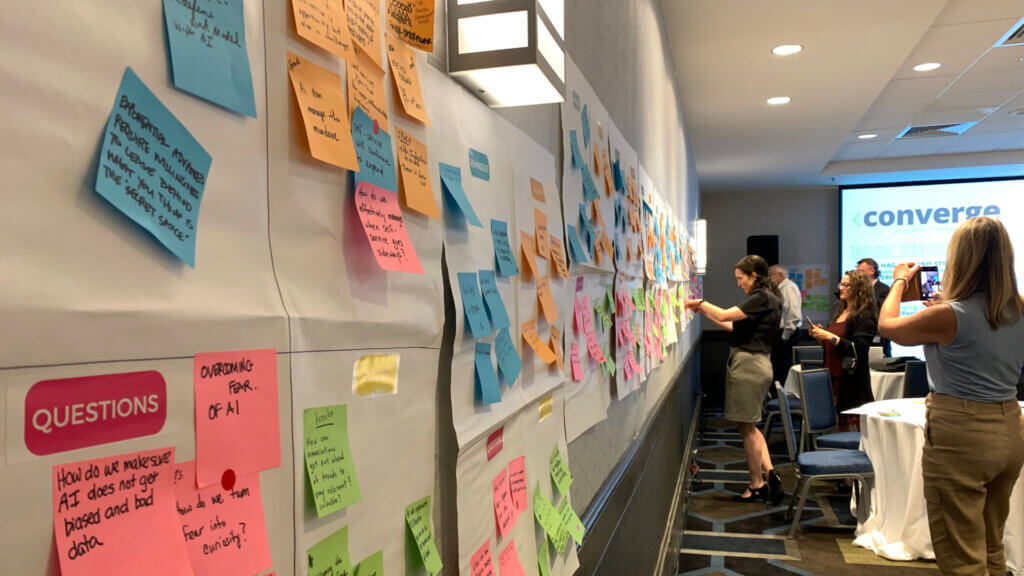
So, at the end of the standard RSQP process, I added a dot voting step. While the participants individually shared their ideas with the others at their table, the staff gave each table a strip of three red sticky dots. When the flip chart sheets were complete, I asked each table to spend three minutes choosing and adding red dots to the three topics on their sheet they thought were the most important for further discussion. Here’s an example of one table’s work.
An initial review of the gallery’s red-dot items, allowed us to quickly zero in on needed and wanted topics. We saw a nice combination of popular ideas and great individual table suggestions. Being able to initially focus on red-dot topics on the flip charts saved us crucial time.
As a result, we determined the topics, assigned facilitators, and scheduled a set of nine sessions in time to announce them during lunch. (Once again, refer to my book Event Crowdsourcing for the step-by-step procedures we used for session selection and scheduling.) We ran the sessions in two one-hour afternoon time slots, and, as is invariably the case with program crowdsourcing, every session was well-attended and received great reviews.
Conclusion
I’m sure there are still great group facilitation techniques I have yet to discover. But my facilitation toolbox doesn’t get as many new tools added each year as when I began to practice professionally. However, when I consider how many possible combinations of my existing tools are available to solve new group work situations, I feel increasingly confident in my ability to handle novel facilitation challenges that may arise.
As my mentor Jerry Weinberg wrote:
“I may run out of ideas, but I’ll never run out of new combinations of ideas.”
—Jerry Weinberg, Weinberg on Writing: The Fieldstone Method
Harnessing Serendipity: a book featuring 66 collaboration artists
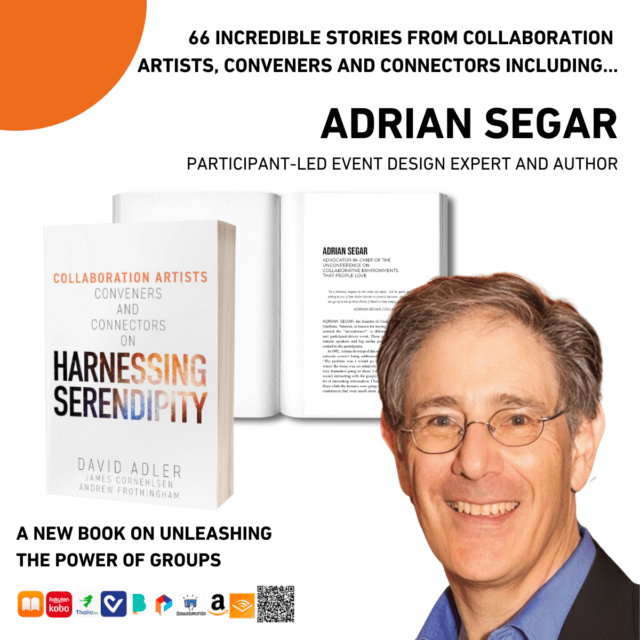
The book, by BizBash founder and friend David Adler, James Cornehlsen, and Andrew Frothingham, classifies the people David calls collaboration artists into six groups. We are people who…
- Create safe spaces for conversations;
- Facilitate awareness for others;
- Foster community and belonging;
- Stimulate creativity;
- Cultivate wonder and curiosity; and
- Nurture empathy.
I appear in the section on fostering community and belonging. However, the work of everyone included in this book incorporates most if not all of these approaches. They are all important modalities that support people coming together to meaningfully connect and collaborate.
The authors define a collaboration artist as follows:
A “Collaboration Artist” knows how to bring people together, enroll them in a common mission, create idea flow, and translate ideas into new solutions to solve problems and drive achievement of important goals. From modest challenges like moving a small corporate initiative forward, to eradicating a disease, whether in small or large endeavors…collaboration equals success!
—”An Invitation”, Harnessing Serendipity
My take on Harnessing Serendipity
Harnessing Serendipity celebrates the art of connection and collaboration. It’s an easy and absorbing read; you can dip into it and pick up little gems everywhere. The book opens your mind to what is possible, yet it’s sobering to realize that it just scratches the surface. I know quite a few of the featured collaboration artists. All of them have much more value to share than can be included in this book.
Perhaps the authors’ greatest gift is to introduce the reader to people who can change how the world thinks about convening, connecting, and collaborating. Certainly, that’s been my focus for the last forty years. I encourage all readers to explore working with any of the people featured in the book, and thank the authors for making us more visible, and perhaps a little more influential than we were before.
Zoom avatars—some thoughts
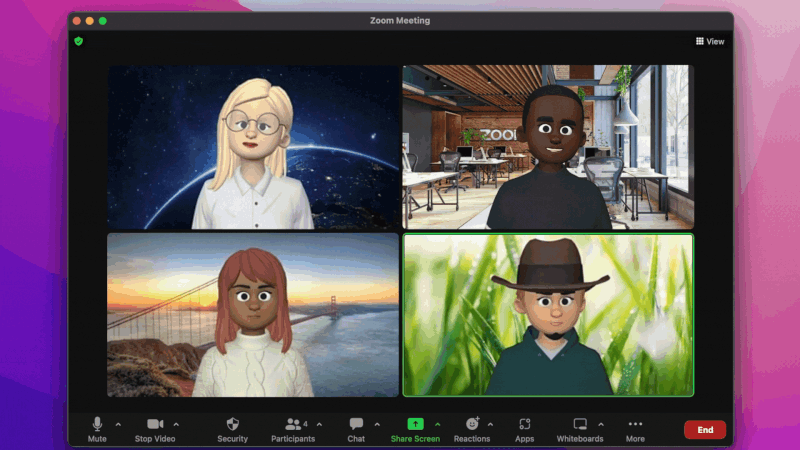
Zoom avatars have received mixed reviews (1, 2), including this reaction from Miguel Neves, Editor-in-chief at Skift Meetings, on LinkedIn:
“Why but why has Zoom created an avatars feature?
They recently announced a bunch of really interesting features. I’m entirely not sold on their feature, this looks like some sort of strange meme.
Say no to #avatars, really.
According to their blog you can ‘choose from extended Animal Avatars, Human Avatars, and even Meta Avatars to help you customize how “virtual you” shows up in meetings’.
Who asked for this?”
My thoughts on Zoom avatars
Some people may find it fun to meet via avatar, perhaps on an occasional basis to surprise others or shake things up. Though, in general, I don’t recommend doing this for a business meeting unless you know the other participants fairly well, I’m a fan of fun.
More seriously, I think there is a good case for making avatars available for the neurodivergent and folks who are—for whatever reason—feeling that they’re not going to be looking good on camera for a meeting. Let’s support the “I” in #DEI.
Supporting a culture where camera-off is not an unusual occurrence is an alternative. I’ve often seen this when working with students, who may be in challenging living spaces. I generally have no problem being on camera. But there have been times when it makes sense for me to turn it off. I suspect that’s true for most people.
And remember it wasn’t so long ago when no one had cameras streaming self-video over the net. We did fine back then. In fact, all cameras-off meetings can be quite refreshing!
So, though I’m not in favor of forcing everyone to display avatars, I don’t have a problem if some people want to use them.
Other perspectives
Nancy Snowden shared a detailed neurodivergent perspective in the comments on Miguel’s post:
“For many neurologically diverse folks, seeing themselves on screen causes a lot of anxiety and distraction. If I were to consider this with a growth mindset I wonder if this is an excellent way to increase an employee’s sense of belonging, maybe help them to be more productive, or hell, maybe make exhaustingly tedious and mundane experience of zoom calls even just a little more bearable.
When I consider my own neurodivergence this feels like a great opportunity- being on camera is distracting, taxing and exhausting for me. It’s harder for me to manage impulse control such as interrupting people, I’m often distracted by something in the background of my screen, but being off camera is seen as being distant or disengaged. When I was in the throes of severe postpartum depression and back to work after 6 short weeks, I could barely manage to shower or brush my hair, the anxiety of having to be on camera felt unbearable, but it felt so expected of me.
Also, being wary and judgmental of something new is exactly why many fumbled the “pivot to virtual” just three years ago. And for some, the outcome was devastating for their business. You don’t have to love something to learn it, bookmark it & have it in your toolbox 🤷🏻♀️”
Joan Eisenstodt reminded us about the past—and the present:
“Years ago, using a few AOL chat rooms, the ability to engage with someone based on content of posts v. their looks all to reconsider the biases in judgement based on someone’s appearance.”
And Jan-Jaap In der Maur had a positive spin:
“This is the first step into the future of us all having one steady digital identity that we ourselves fully own.”
[IMO, I’m skeptical that a) Zoom is interested in putting energy into this, and b) that it’s likely to occur.]
Conclusion
To summarize, I’m fine with Zoom adding avatars. However, I hope the company doesn’t put too much time into tweaking this feature at the expense of developing functionality that I think is more important, such as improved tools for meeting facilitation.
All my ebooks are now available on VitalSource!
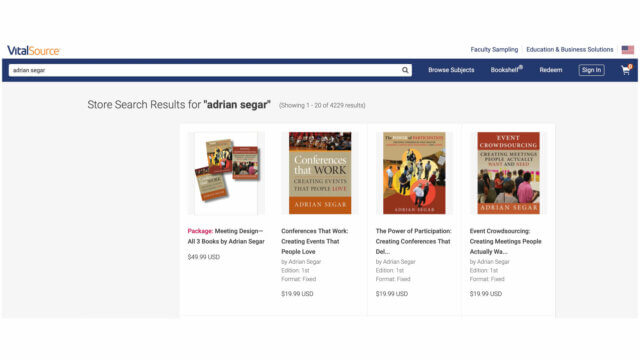
I’m confident that this new channel will be a valuable addition to your curriculum. Check to see if your school already makes books available via VitalSource Campus Retailers.
It is critical to understand how to design conferences and events effectively. My books offer practical advice and best practices for designing and executing successful participant-driven and participation-rich meetings, whether they are virtual or in-person, and they are used by numerous meeting and hospitality education programs.
Now, you and your students can easily access my books from anywhere in the world, at any time, both online and offline. VitalSource’s platform, BookShelf, is user-friendly and intuitive, making it easy for you to incorporate my books into your coursework.
In addition to providing access to my books, VitalSource also offers valuable tools for instructors. These include a platform for creating and sharing course materials, customizable content, and analytics to track student engagement and progress. In addition, VitalSource’s Faculty Sampling Portal allows instructors or faculty members currently teaching at a school or institution to review my books for free before adding them to your curriculum.
I am happy to partner with VitalSource to make my books on meeting design more widely available to students and faculty members around the world. I look forward to hearing your feedback on how my books have helped to enhance your students’ learning experiences.
And, of course, if you or your students prefer, my ebooks are still available for purchase directly from this website.
Thank you for your ongoing support of my work and your commitment to advancing the field of meeting design!
Sincerely,
Adrian Segar
Using pair share for group work practice
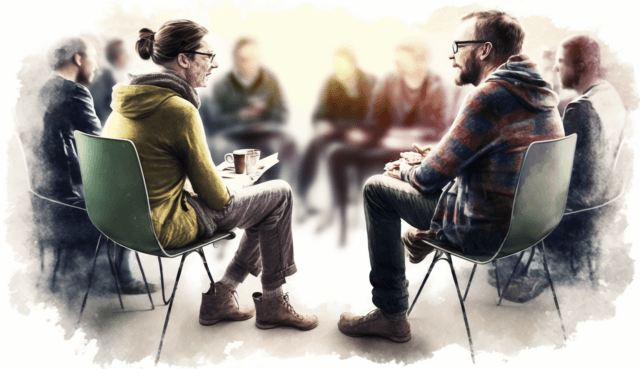
Rachel and I were preparing for another core facilitation technique I use at the start of meetings: The Three Questions. Participants think about their answers to the questions and then share their answers, in turn, with the group. We were reviewing Rachel’s outline and I came across an addition to the process.
“Practice Round (3 minutes). Now, turn to the person next to you and in 60 seconds or less, share your answers. Ask for feedback.”
Rachel had added a pair share to allow all participants to practice their answers before sharing with the entire group.
I immediately loved and saw the value of her idea!
I devised The Three Questions thirty years ago and have run it hundreds of times, but I’d never considered this improvement. Though I mention common slip-ups to participants, such as spending too long on the first question, they sometimes still occur. Allowing everyone to practice their answers with one other person before group sharing is a simple and effective way to help each participant:
- Feel more confident about their answers;
- Get personal feedback; and
- Provide better answers to the group.
Conclusion
I will be adding Rachel’s small but valuable improvement to my future sessions of The Three Questions. As a proponent of lifelong learning, I’m happy to use observations, feedback, and trying new things to continually refine what I do. A generous hat tip to Rachel LaForgia, Senior Program Director of the Peace and Security Funders Group, for sharing this simple application of pair share for group work practice with me!
The ultimate in social listening
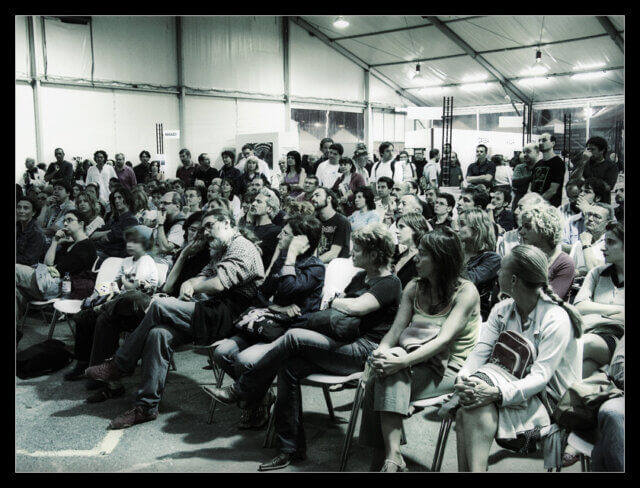
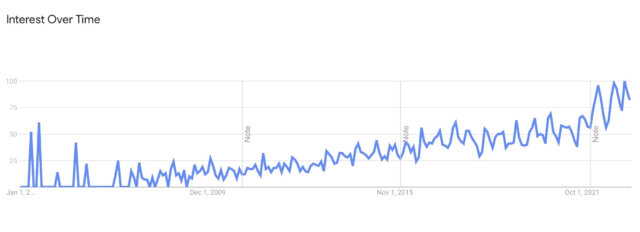
Initially confined to sentiment analysis, social listening tools can now identify trends, analyze competitors, track influencers, identify crises and potential issues, and monitor reputations.
A wider perspective on social listening
With this recent emphasis on social listening as something done on social media, it’s easy to forget what it was for all of human history prior to 2004. Just because we now have tools that quantify awareness and sentiment, we shouldn’t discard older methods of finding out what audiences think and feel.
Indeed, quantification of what has historically been seen as subjective may be misleading. Traditional meeting evaluations turn out to be unreliable. Motivational speakers rarely have a significant long-term impact, even though audiences often rate them highly immediately after their speech. And, with the majority of social media traffic now occurring on dark social channels like Facebook Messenger, WhatsApp, and TikTok, who knows how accurately numbers derived from Facebook, Twitter, and LinkedIn reflect reality?
A different way to think about social listening
Last week, I facilitated the second BizBash Leadership Summit, an unconference I designed for “30 executives across experiential, event tech, and other corporate verticals”. During one of the sessions, BizBash’s founder, David Adler, asked, “What does social listening mean in the context of understanding the impact of an event?”
And then, during my closing session, he answered his own question.
I typically close unconferences with a simple process, plus/delta. Participants first publicly share their positive experiences. After they’ve aired them, they also suggest changes that they think might make the event better in the future. The beauty of plus/delta is that it rapidly builds a collective experience of the conference. This widens individual perspectives of what happened and builds community around the shared collective experience.
The Leadership Summit was clearly successful. Many participants wanted to meet again, even suggesting ways to do so. We also heard great feedback on how the event could be further improved (making it longer was a popular suggestion), giving the conveners valuable ideas for future gatherings.
It was then that David said, “Isn’t this what we’re doing right now, the ultimate in social listening?”
I think he was right. We weren’t quantifying sentiment. There were no ten-point-scale smile sheets. Rather, we’d been having intimate conversations for three days, getting to know each other and building community around our shared experiences. And now, we were listening to each other in important ways and making plans for our group’s future.
Our experience together changed us and inspired us to make changes in our lives, both individually and collectively. I think that’s the ultimate goal of social listening—creating change that matters.
Image attribution: Flickr user iguanajo

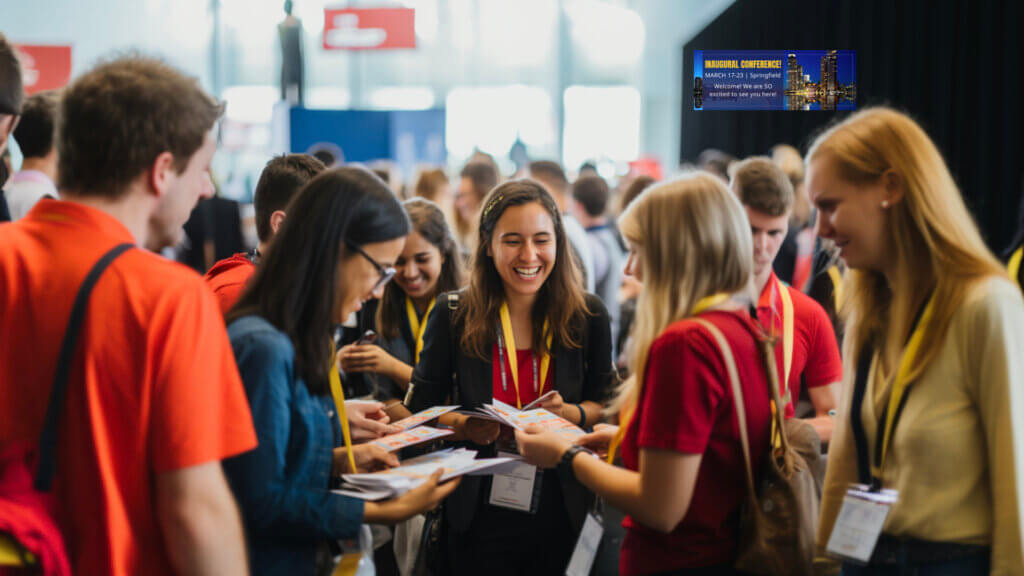 Keeping a recurring conference going, alive and fresh every time, is hard enough. Successfully starting a conference from scratch is even tougher.
Keeping a recurring conference going, alive and fresh every time, is hard enough. Successfully starting a conference from scratch is even tougher.